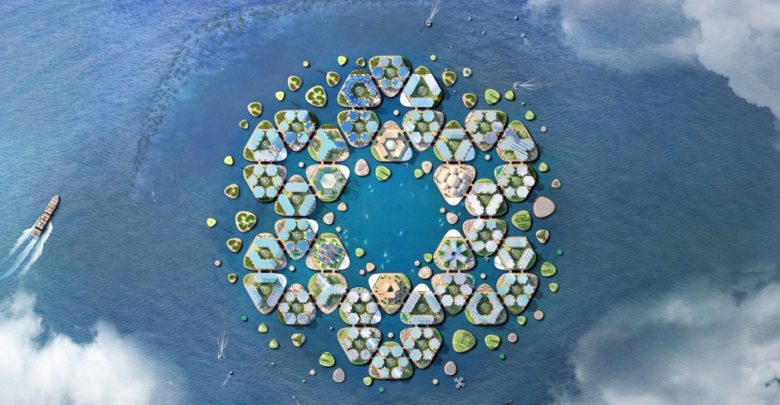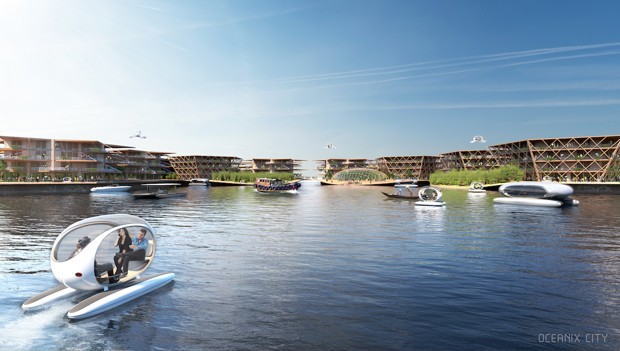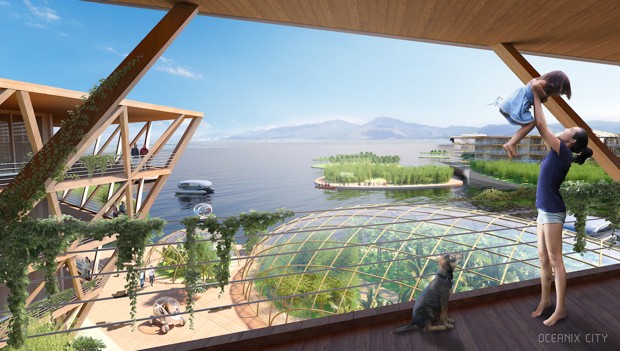

From above, the speculative city looks a bit like a flower, with shiny petals of solar-roofed, man-made islands ringing a central port area. The 4.5-acre islands would not actually float free, but would be anchored to the sea floor by biorock, a material that’s used to build artificial coral reefs. For drinking water, the putative residents of Oceanix City would extract humidity from the air and desalinate seawater; their food would be harvested from small floating farms and under water via aquaculture. Oceanix City would be both hurricane-resistant and zero-waste.

After the presentation, UN officials expressed skepticism, given the major unanswered questions about feasibility, cost, and the wisdom of building new infrastructure offshore when so much of what we have on land needs upgrading.
Actually, that didn’t happen. Instead, officials and dignitaries praised Collins and Ingels’s concept. Victor Kisob, the deputy executive director of UN-Habitat, told National Geographic: “Listening to Marc and seeing his designs, this seems futuristic but it really is practical.” Joseph Stiglitz, the Nobel Prize-winning economist, spoke approvingly of the proposal as well. “It’s certainly worth trying,” he told Nat Geo. “The only way you’re going to find things out is to actually do these things.”
The UN has not committed any funding to the plan, although it organized the roundtable and encourages further research into floating cities.
Should UN-Habitat—the UN agency responsible for sustainable urban development—be toying with a moonshot response to climate change, one that emerged from the techno-utopian seasteading movement that’s long been a focus of libertarian fascination? (Collins, a former minister of tourism for French Polynesia, has dabbled with libertarian seasteads and is featured on the Seasteading Institute’s website as an “ambassador.” However, Oceanix says it wants to offer affordable housing for climate-affected megacities.)
“They haven’t figured it all out. They’re conceptualizing this,” he told me. (Sawislak used to direct resilience work for AECOM, the global infrastructure firm, and he collaborated with BIG in that capacity.) “But to show people what it could look like, and the whizz-bang-cool [design] stuff, helps people imagine this could really happen.”
Sawislak said the way the project thinks about water—that is, choosing to live with it rather than hopelessly fighting against it—is “absolutely the right idea.” People live on houseboats in Seattle, Amsterdam, and other cities. “The idea that we can essentially reclaim land or create new land in the water—I don’t think that’s revolutionary. What these guys are talking about is, ‘How do we do that in a way that solves some of the other problems?’” He cited the harvesting of energy from wave action as an especially exciting possibility.
What about the cost? “We’re going to spend billions of dollars anyway,” he replied, whatever courses of actions we do or don’t take.
Maybe the leading designers and engineers assembled for the project can make breakthroughs that will help communities across the world adjust to a warmer, stormier, drought- and flood-prone future. Maybe a vision that blends Buckminster Fuller, Logan’s Run, and the seductive marketing of the Fyre Festival will galvanize public support for climate action. But it’s not hard to spot the problems with the Oceanix approach.
Oceanix City would sit a mile or so off the coast. Its near-self-sufficiency could be a source of resilience in some circumstances—for example, if there were a blackout on the mainland. But isolated, closed urban systems have their own weaknesses. What if, say, the energy storage failed and the desalination plant went down as a result? If the city could not bring in the technicians or new parts needed to fix the equipment, things could go downhill fast. Of course, engineers could design redundancy into the technology. But with all the unknowns of climate change, how much would be enough?

Kian Goh, an assistant professor of planning at UCLA, researches urban politics and climate-change adaptation. Projects like Oceanix City “are oftentimes posed as solving some big problem, when in many ways [they’re] an attempt to get away from the kinds of social and political realities of other places,” she said.
The Oceanix/BIG design is generic as to place—exactly where it would be, and whether it would come under the jurisdiction of any city’s or country’s laws, is unclear. (“The first OCEANIX Cities are calibrated for the most vulnerable tropical and sub-tropical regions around the globe,” according to the company’s website.) If the city were built by private investors in the open ocean and answered to no governmental authority, it could easily become a climate haven, like a tax haven, for those who had the money to buy into it.
Floating infrastructure and neighborhoods may work well in some parts of the world, like the Netherlands. But in many other places, “it’s not clear at all that retreating to these pod cities of 10,000 people each is going to solve anything,” Goh said. In Jakarta, for instance, if the city keeps sinking at the same rate it is now, 4 to 5 million peoplemight be displaced. A dozen Oceanix Cities would barely make a dent in that crisis.
The flaw in the Oceanix vision is not its utopianism: Utopian thinking is essential, now more than ever. But this is a narrow, escapist, apolitical utopia, rather than a truly bold and capacious one. In Goh’s words, “We do need utopian visions” for sustainable cities in the era of climate change. “But the utopian visions have been wrong so far.”
Artikel ini telah dipublikasikan di https://www.citylab.com/environment/2019/04/floating-cities-climate-change-united-nations-sea-level-rise/586612/
Oleh: Amanda Kolson Hurley, CityLab



